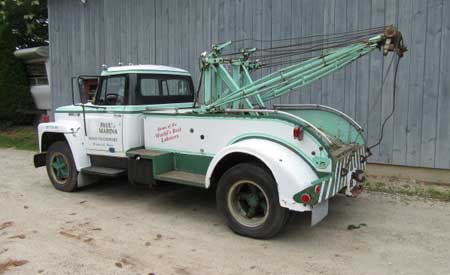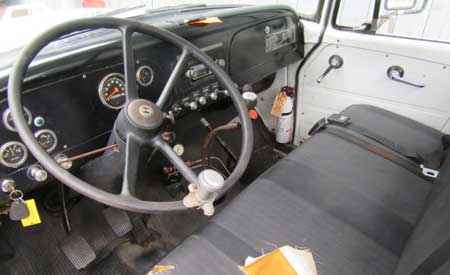As I delve further into the collector car and truck market, I find that there are a lot of unusual and unique cars and trucks out there. Though I usually use the eBay or craigslist to find my next subject vehicle, I do use Hemmings Motor News from time to time. In fact, I used it to find this 1976 International Loadstar 1600, which is fitted with a 1949 Nash twin-boom wrecker body. Find it here at Goldenrod Garage in Freeport, Maine, with an asking price of $3,950.
Produced from 1962 to 1979, the International Harvester Loadstar was a replacement for the medium and heavier-duty R-series (built from 1952 to 1972) and was primarily used for local delivery, construction, and agricultural applications, as well as utility and fire trucks. The Loadstar 1600 was the entry-level medium-series truck, and this 1976 model features the optional one-piece tilt hood, which was available as an option beginning in 1972. At some point, this 1976 Loadstar 1600 was fitted with a 1949 Nash wrecker body, and judging by the fitment, whoever undertook this conversion did a nice job. The truck is painted in white, black and sea green, and features some kind of vintage tow company lettering (unfortunately, the lettering is hard to read; if one of the viewers reading this has really good vision and knows what it says, let me know in the comments section). The paint needs to be touched up by the boom, but otherwise the rest of the paint and lettering appears to be in good condition. I would touch up the paint by the boom, remove the piece of wood on the front bumper, and make sure the tires are in good condition.
Though a number of engines were available in the Loadstar (gas-powered straight sixes, diesel engines, and 304 and 392 V8s), this truck is powered by the 345 V8 and backed by the 4-speed manual transmission with the two-speed rear. Rated at 193 gross horsepower and 309 lb-ft of torque, the 345 is reportedly underpowered by International Harvester collectors (I’ve been scouring blogs for owner’s opinions), but since the 345 features a two-barrel carburetor, I think a swap to a four-barrel carburetor from a 392 would help power a bit. The engine appears to be in decent shape, but the engine could use a good detailing, and I would repaint the firewall while the engine is out. I would also swap out the Exide battery and source a vintage truck battery, and run the 345 V8 for a while before swapping the engine out for a diesel. Supposedly the 7.3L Ford Powerstroke and GM 6.2 diesel and 6.5L turbo diesel are popular swaps, but I would do the research before executing the swap.
Inside, the truck’s interior is in decent shape, but there are a few things that need to be addressed. The seat has a few tears on the top of the cushion, and the rubber mat appears to be a bit warped on the driver’s side. The shifter also has a bit of surface rust on the shifter arm. Otherwise, the rest of the interior is in great condition, and presents very well. I would reupholster the seat cushion, try to fix the floor mat on the driver’s side, and have the shifter arm redone. Overall, this Loadstar tow truck is very unusual, and judging by the price, I doubt you will find another cheaper and with this unique body. What are your thoughts on this one-of-a-kind Loadstar 1600 twin-boom tow truck?






Mitchell,why is it you feel that on about every vehicle you write up needs an engine swap or upgrade or some other major modification? How about just giving us the facts? Just my thoughts…
All the writers here give suggestions/opinions,I appreciate that. I learn from these guys, and it’s interesting.
In the words of the great Room Swanson, I can do what I want
I agree Mitchell. You don’t go put a 4 bbl carb on an old truck engine without doing something else. The increased fuel would surely not be good for an old motor. These old Internationals weren’t ever known for lots of power but the gearing made them very reliable trucks for a variety of applications.
Why not swap for a 4bbl from another 345? Like the one in the 1/2 ton pickup? This is a low speed local wrecker in any event. Probably has all the power it needs. Spoke wheels can be a nightmare. Many shops won’t even deal with them.
The most intelligent swap would be for one of the great IHC DT466 mechanical injected engines ( that were an option in this chassis) but it would also be nessisary to change the rear differential ratios to accommodate the lower RPM engine, an appropriate transmission to work with the heavier clutch and torque engine…….in short. Start with a truck that already has that stuff and if you like install a wrecker body. They are cheep, have been made obsolete by the insurance companies that don’t want to write policies for them any more.
I always thought the tilt hood was the 1700 and the 1600 was the butterfly hoods, but apparently, you could get either in ’76. I can’t find when they stopped the butterfly hood. I wholeheartedly endorse Mitchell’s idea of putting a better motor in this, and please, don’t start, I just don’t like these motors (and I can smell the gas from here) and sloppy steering was standard in every Loadstar I drove. The wood piece is a push bar, of sorts. I agree, not needed. Hiding that nice chrome bumper. Dave is Wright :) lose the tubes, but they aren’t as hard to repair as Dave says, any truck tire shop or truck stop still works on them, Probably not Walmart, though. These were great trucks, couldn’t kill them, provided the engine ran right, and for me, they rarely did. You never left the yard in a Loadstar without some tools. Not sure what to do with this, boom lifts are horribly out of date, and I’d try and find a Nash Truck ( good luck with that) and donate this wrecker body and make something more useful out of this,,,with a better motor. Like Dave says, the 466 was a heck of a better motor.http://s.hswstatic.com/gif/1947-1954-nash-model-3148-1.jpg
I don’t think the tilt hood was an option, rather an upgrade for S body trucks built after about the time this one was. The butterfly hoods were ugly to work under….these are much better. I had a nearly identical one to this with 4×4,that we put a flatbed and a small crane on to clean up boat wrecks on the beach. Serviceable truck. It had been a California Department of Forestries wild land fire truck. Drove it home from Alturas to Santa Barbera…….a long trip. Was a fun truck, sat very high, was slow but drove good.
Hi Dave, those butterfly hoods were a pain. More than once, leaning over the fender tinkering with the carb, I had those hood ratchet stay things fail, or not release. https://upload.wikimedia.org/wikipedia/commons/b/b2/International_Loadstar_AWD.jpg
Sort of looks like a short guillotine………I have bad memories of working under them too.
Leave it the way it is, the back of truck is almost 70 years old, the front 41 years old, it’s a work truck, no need to paint inside of engine, use it for 500 miles a year, that’s it. Beef up something that’s worth it.
The bed and boom are the money shot looks wise, the front not so much. Although it’s older it really doesn’t say “classic” when you look at it. As was already mentioned, save the back end for a period correct project, the rest is just a solid older truck that might have have a few more years of work left to do before retirement.
You may notice this truck has no tow sling on it. It would appear the only thing you could tow with it is a pintel hitch trailer. If you hooked a vehicle with those cables, at your first stop, you would get rear ended by whatever you were towing.
The original Loadstar replaced Binder’s medium line, such as the B-160 through the 180. The HD (R & V series) line continued until the S-series took over. Yes I used to play dumpster diver when I worked on the ones with the butterfly hoods. Did I like standing on my head? Not!
This cab is a slightly modified Pickup cab with different front hood and fenders. Dodge did the same thing with ther heavy trucks.
Speculating on what engine might be a good swap for this truck is just talking ‘smack’. Old Binders like this are sitting all over the country, out of service. There is nothing about it (the basic truck chassis) that is noteworthy. The Nash wrecker body is, as some else said, the potentially attractive part of this deal if one wanted a ‘period’ wrecker. There are far more interesting chassis/cab candidates than the Loadstar.
As for the cab being shared with the pickup, that was common practice for Ford, Dodge, Chevy/GMC for decades. In the IH world though, it is more correct to say the big truck cab was shared with the pickup…given the enormous difference in production volume of the Loadstar vs the miniscule pickup sales.
And, lastly….I agree many/most of us do not require more than detailed facts about the vehicles featured….we have our own imaginations and preferences to add in the mix. The narrator, by his own admission above, is taking advantage of the ‘bully pulpit’ opportunity.
I had a 78 Loadstar 1700
I remember the engine being an MV 404 and it ran like a Swiss watch. Donated it to a Christian camp in northern Wisconsin in about 1984…in the winter… was so cold crossing Wyoming in December, we had to scrape the frost off the INSIDE of the windows to see to change lanes. The camp used it for several years. Great trucks. Love them
We put cardboard in front of the radiator at those times.
There are dozens of these still in use on farms all around here, and dozens more sitting unused in fields and barns. Not exactly rare in my area. Now the tow bed is a different story, find a 49 or early 50’s truck for it then you would have something! I drove one of these with a Holmes wrecker back in the 70’s. It was a rough riding, noisy, and hot ride ( and I don’t mean fast ). I hated that truck and would only use it if the GMC wasn’t available. In my opinion, spending the time and money to do an engine swap would be a major waste of resources.